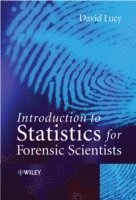
- Format
- Häftad (Paperback / softback)
- Språk
- Engelska
- Antal sidor
- 272
- Utgivningsdatum
- 2005-11-01
- Upplaga
- 1
- Förlag
- John Wiley & Sons Inc
- Medarbetare
- Lucy
- Illustrationer
- Illustrations
- Dimensioner
- 245 x 170 x 18 mm
- Vikt
- Antal komponenter
- 1
- Komponenter
- 67:B&W 6.69 x 9.61 in or 244 x 170 mm (Pinched Crown) Perfect Bound on White w/Gloss Lam
- ISBN
- 9780470022016
- 480 g
Introduction to Statistics for Forensic Scientists
- Skickas från oss inom 5-8 vardagar.
- Fri frakt över 249 kr för privatkunder i Sverige.
Passar bra ihop
De som köpt den här boken har ofta också köpt Who's Afraid of Gender? av Judith Butler (inbunden).
Köp båda 2 för 968 krKundrecensioner
Recensioner i media
It deserves a place in the library of any serious forensic scientist and I congratulate the author on his achievement. (Significance, 1 March 2006) "useful for those who are becoming introduced to forensic science." (The American Statistician, August 2007) "...the book is an easy read...it would appeal to students of forensic science at both introductory and advanced levels." (Journal of Tropical Pedriatrics, 2nd February 2006) " deserves a place in the library of any serious forensic scientist and I congratulate the author on his achievement." (Significance, Issue 3, 2006) " an easy read with many complex concepts described in a lucid style." (Journal of Tropical Pediatrics: Vol. 52; 4, 2006) "One of the most important issues in using likelihood ratios in a forensic context may well be determining the relevant population of a sample. This is an are that is discussed throughout the textgives insight" (Canadian Society of Forensic Science, October 2006)
Övrig information
Dr. David Lucy, School of Mathematics, The University of Edinburgh.
Innehållsförteckning
Preface. List of Figures. List of Tables. 1. A short history of statistics in the law. 1.1 History. 1.2 Some recent uses of statistics in forensic science. 1.3 What is probability?. 2. Data types, location and dispersion. 2.1 Types of data. 2.2 Populations and samples. 2.3 Distributions. 2.4 Location. 2.5 Dispersion. 2.6 Hierarchies of variation. 3. Probability. 3.1 Aleatory probability. 3.2 Binomial probability. 3.3 Poisson probability. 3.4 Empirical probability. 4. The normal distribution. 4.1 The normal distribution. 4.2 Standard deviation and standard error of the mean. 4.3 Percentage points of the normal distribution. 4.5 t-testing between two independent samples. 4.6 Testing between paired observations. 4.7 Confidence, significance and p-values. 5. Measures of nominal and ordinal association. 5.1 Association between discrete variables. 5.2 X2 test for a 2 x 2 table 5.3 Yules Q. 5.4 X2 tests for greater than 2 x 2 tables. 5.5 02 and crammers V2. 5.6 The limitations of X2 testing. 5.7 Interpretation and conclusions. 6. Correlation. 6.1 Significance tests for correlation coefficients. 6.2 Correlation coefficients for non-linear data. 6.3 The coefficient of determination. 6.4 Partial correlation. 6.5 Partial correlation controlling for two of more covariates. 7. Regression and calibration. 7.1 Linear models. 7.2 Calculation of a linear regression model. 7.3 Testing 'goodness of fit'. 7.4 Testing coefficients a and b. 7.5 Residuals. 7.6 Calibration. 7.7 Points to remember. 8. Evidence evaluation. 8.1 Verbal statements of evidential value. 8.2 Evidence types. 8.3 The value of evidence. 8.4 Significance testing and evidence evaluation. 9. Conditional probability and Bayes' theorem. 9.1 Conditional probability. 9.2 Bayes' theorem. 9.3 The value of evidence. 10. Relevance and the formulation of propositions. 10.1 Relevance. 10.2 Hierarchy of propositions. 10.3 Likelihood ratios and relevance. 10.4 The logic of relevance. 10.5 The formulation of propositions. 10.6 What kind of propositions can we not evaluate. 11. Evaluation of evidence in practice. 11.1 Which database to use. 11.2 Verbal equivalence of the likelihood ratio. 11.3 Some common criticisms of statistical approaches. 12. Evidence evaluation examples/ 12.1 Blood group frequencies. 12.2 Trouser fibres. 12.3 Shoe types. 12.4 Airweapon projectiles. 12.5 Height description from eyewitness. 13. Errors in interpretation. 13.1 Statistically based errors of interpretation. 13.2 Methodological errors of interpretation. 14. DNA I. 14.1 Loci and alleles. 14.2 Simple case genotypic frequencies. 14.3 Hardy-weinberg equilibrium. 14.4 Simple case allelic frequencies. 14.5 Accounting for sub-populations. 15. DNA II. 15.1Paternity -mother and father unrelated. 15.2 Database searches and value of evidence. 15.3 Discussion. 16. Sampling and sample size estimation. 16.1 Estimation of a mean. 16.2 Sample sizes for t-tests. 16.3 How many drugs to sample. 16.4 Concluding comments. 17. Epilogue. 17.1 Graphical models and Bayesian Networks. 17.2 Kernel density estimation. 17.3 Multivariate continuous matching. Appendix A: Worked solutions to questions. Appendix B: Percentage pints of the standard normal distribution. Appendix C: Percentage points of t-distributions. Appendix D: Percentage points of X2-distributions. Appendix E: Percentage points of beta-beta distributions. Appendix F: Percentage points of f-distributions. Appendix G: Calculating partial correlations using 'Excel' software. Appendix H: Further algebra using the "third law". References. Index.


